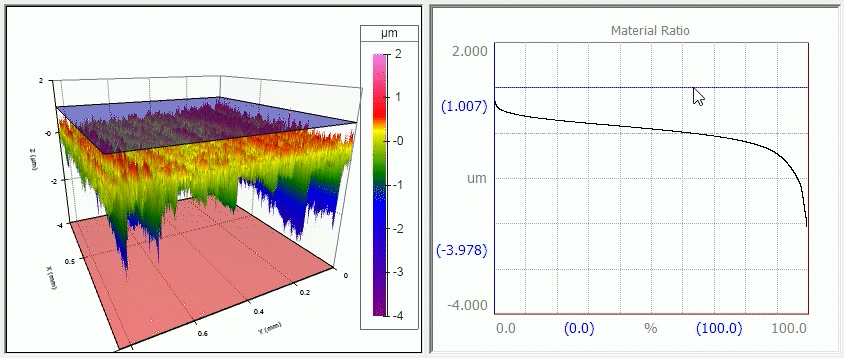The “material ratio curve” tells us how much material we encounter (as a percentage) as we slice through a surface at various depths. You may also see it called the Abbott-Firestone Curve (based on the two engineers who developed it) or the Bearing Ratio Curve. The curve appears is a standard component of our OmniSurf, OmniSurf3D, TraceBoss, TraceBoss+, and other software.

The gif above, from OmniSurf3D, shows the plane as it passes from just above the surface all the way in to the bottom of the valleys. The highest slice (0%, at the left of the curve) only contacts the very tallest peak and otherwise passes only through air. As we slice further down into the surface, we encounter a higher percentage of material. The bottom slice (the right side of the curve) is just lower than the deepest valley and therefore passes through 100% material.
The Material Ratio Curve is a critical part of the surface texture analysis toolkit because it tells us a lot about the type of surface we have. Does the surface have a lot of peak material, or many deep valleys? The Rk parameters (Rpk, Rk, Rvk) that we derive from the curve tell us about these peak, core, and valley regions.
We can also look at the material ratio curve over time to understand how a surface wears. The surface of a brand new component may have quite a bit of peak material from the machining processes. As the part wears (perhaps through contact with other components), that peak material may be plastically deformed or sheared off, and debris from the peaks may fill in the valleys. In applications such as engine bores and cylinders, how the surfaces change over time is as critical to performance as what the surface looks like as it is manufactured. The material ratio curve is indispensable in applications like this.
We have quite a bit of information available discussing the Material Ratio curve, the Rk Parameters. Here are a few resources to start with:
Learn more here:
The Surface Texture Answer Book dedicates many pages to the topic as well.
